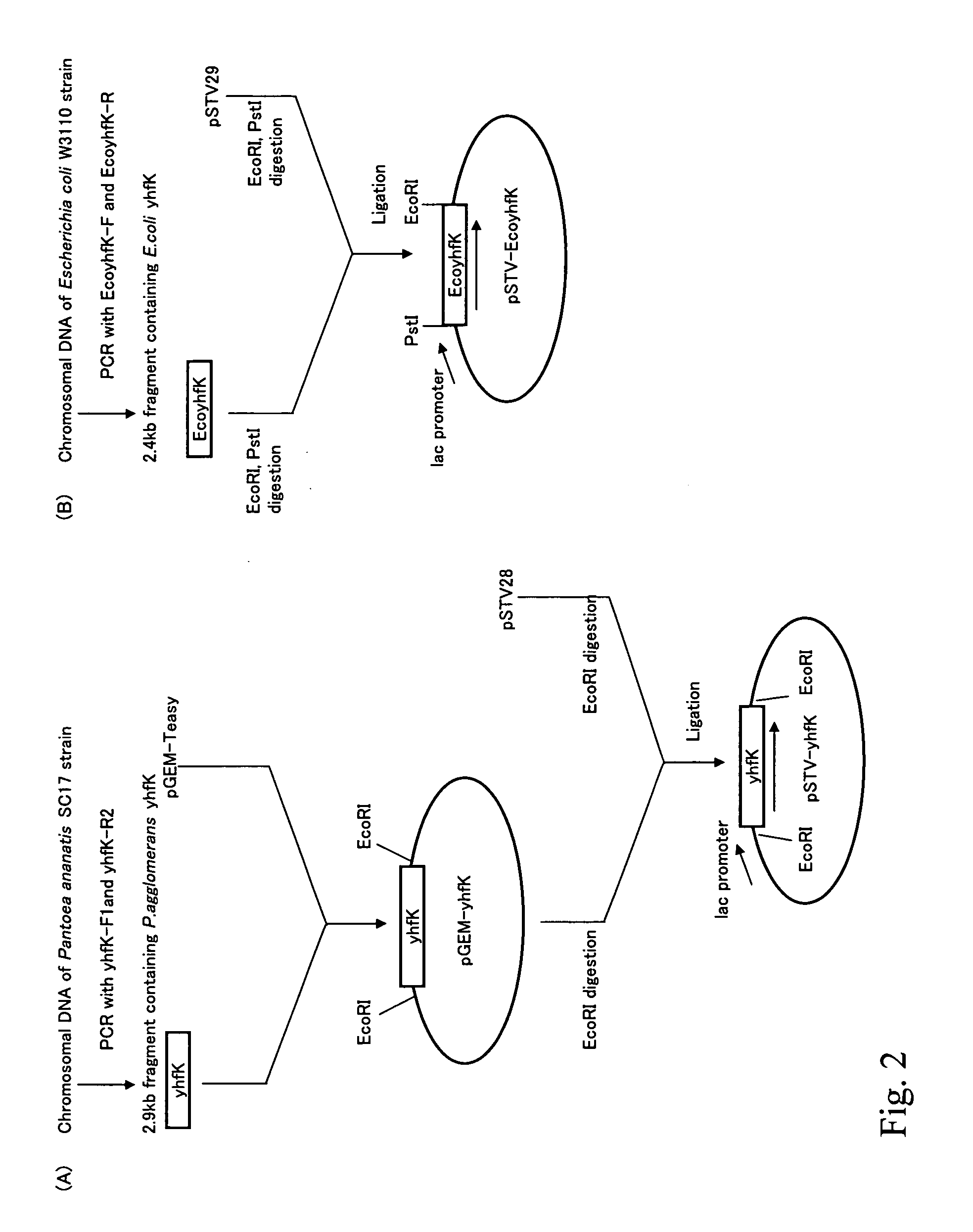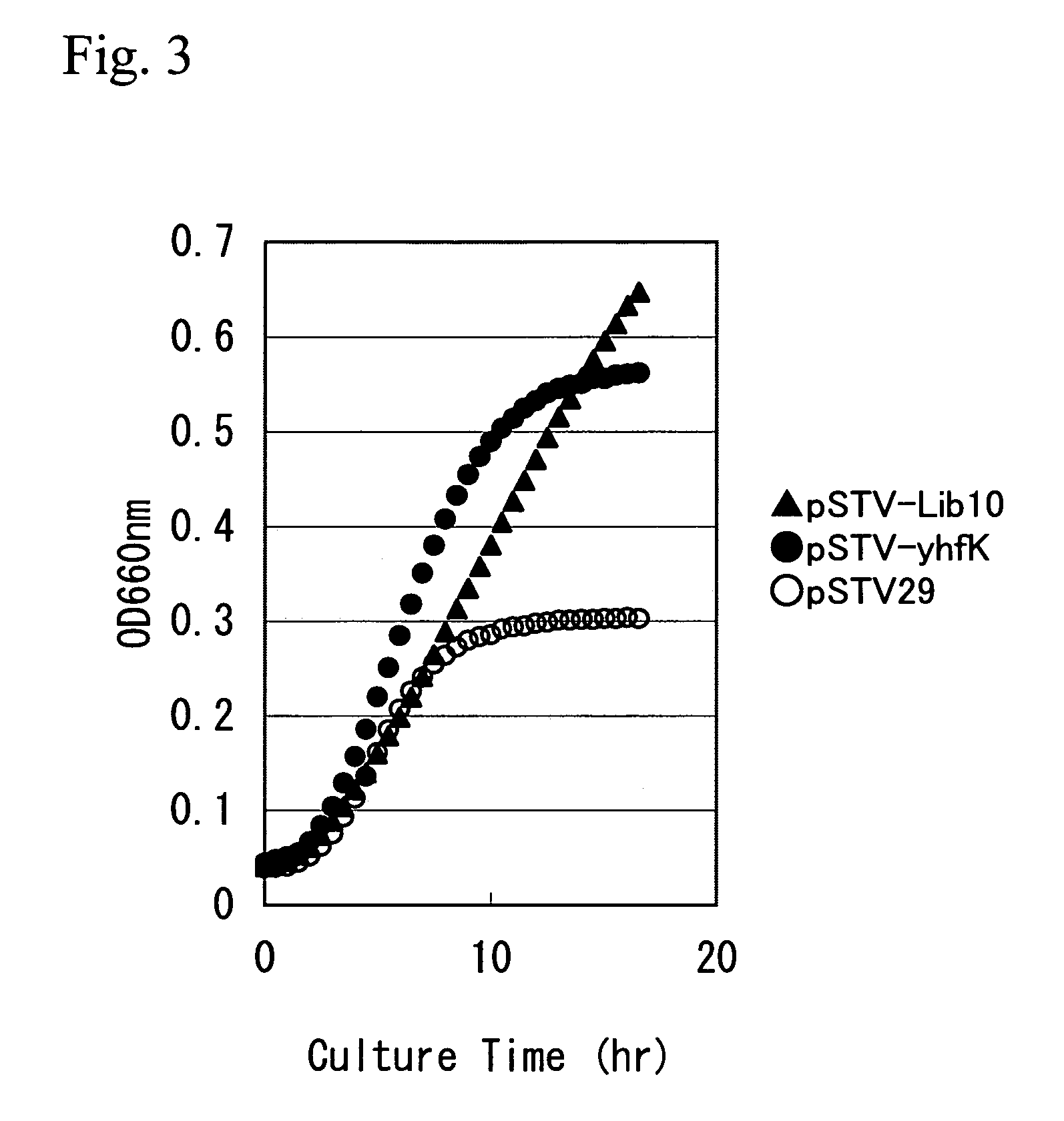L-glutamic acid-producing microorganism and a method for producing L-glutamic acid
a technology of l-glutamic acid and microorganisms, which is applied in the field of l-glutamic acid production methods, can solve the problems of decreased bacterial cell growth, increased intracellular l-glutamic acid concentration, and no gene has been reported that can impart l-glutamic acid resistance to host microorganisms, etc., and achieves the effect of efficient production by fermentation
- Summary
- Abstract
- Description
- Claims
- Application Information
AI Technical Summary
Benefits of technology
Problems solved by technology
Method used
Image
Examples
example 1
[0153]
[0154]Screening of the L-glutamic acid-export gene was performed as follows. Since L-glutamic acid is converted into an intermediate of the tricarboxylic acid cycle, 2-oxoglutarate, in one step by glutamate dehydrogenase, it is expected that L-glutamic acid flowing into cells under acidic conditions is easily metabolized in many microorganisms having glutamate dehydrogenase and the tricarboxylic acid cycle. Alternatively, a strain in which 2-oxoglutarate dehydrogenase gene is disrupted exhibits sensitivity to L-glutamic acid under acidic conditions. In this example, by using the Pantoea ananatis SC17sucA strain (JP2001-333769A) as a 2-oxoglutarate dehydrogenase-deficient strain, obtaining an L-glutamic acid-export gene based on L-glutamic acid-resistance under acidic conditions was attempted.
[0155]Chromosomal DNA was extracted from the Pantoea ananatis AJ13355 strain in a conventional manner, and partially digested with the restriction enzyme Sau3AI Then, a plasmid library was...
example 2
[0161]
[0162]Because it was suggested that yhfK might encode a transporter on the basis of a search of protein motifs (J. Mol. Microbiol. Biotechnol., 2(2):195-198, 2000), it was decided to examine the effect of amplification of yhfK gene among the aforementioned genes.
[0163]The yhfK gene fragment was amplified by PCR using the oligonucleotides yhfK-F1 and yhfK-R2, which have nucleotide sequences shown in SEQ ID NOS: 5 and 6, respectively, and are from a chromosomal DNA of a wild-type strain of Pantoea ananatis, No.359 (AJ13355). pGEM-yhfK was prepared by ligating the obtained fragment to a TA-cloning vector, pGEM-Teasy (Promega). pGEM-yhfK was digested with EcoRI and ligated to EcoRI-digested pSTV28 (Takara Bio) to construct a vector pSTV-yhfK for yhfK gene amplification. The construction scheme of the plasmid is shown in FIG. 2.
[0164]The vector pSTV-yhfK for yhfK gene amplification and a control plasmid, pSTV28, were each introduced into the SC17sucA strain by electroporation, and ...
example 3
[0168]
[0169]Then, in order to examine effect of this gene on L-glutamic acid production, the plasmid for yhfK amplification, pSTV-yhfK, was introduced into the L-glutamic acid-producing bacterium SC17sucA / RSFCPG which contains RSFCPG, a plasmid for L-glutamic acid production having a nucleotide sequence shown in SEQ ID NO: 9 (European Patent Publication 1078989).
[0170]The plasmid pSTV-yhfK and the control plasmid pSTV29 (Takara Bio) were each introduced into SC17sucA / RSFCPG by electroporation, and transformants were selected based on chloramphenicol-resistance. After confirming the presence of the plasmids, the strain containing the plasmid for yhfK amplification was designated SC17sucA / RSFCPG+pSTV-yhfK, and the control pSTV29-containing strain was designated SC17sucA / RSFCPG+pSTV29.
[0171]Then, the L-glutamic acid producing ability was examined by culturing the SC17sucA / RSFCPG+pSTV-yhfK and the control SC17sucA / RSFCPG+pSTV29. The composition of the medium is as follows.
[0172][Composi...
PUM
| Property | Measurement | Unit |
|---|---|---|
| pH | aaaaa | aaaaa |
| temperature | aaaaa | aaaaa |
| temperature | aaaaa | aaaaa |
Abstract
Description
Claims
Application Information
 Login to View More
Login to View More - R&D
- Intellectual Property
- Life Sciences
- Materials
- Tech Scout
- Unparalleled Data Quality
- Higher Quality Content
- 60% Fewer Hallucinations
Browse by: Latest US Patents, China's latest patents, Technical Efficacy Thesaurus, Application Domain, Technology Topic, Popular Technical Reports.
© 2025 PatSnap. All rights reserved.Legal|Privacy policy|Modern Slavery Act Transparency Statement|Sitemap|About US| Contact US: help@patsnap.com



